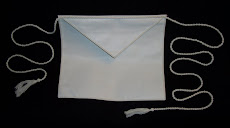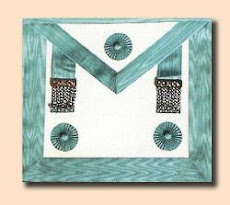The Chevalier Ramsay used to declare: ìFreemasonry is indeed the resurrection of the Noachide religion, that of the Patriarch Noah, that religion prior to any dogma, which allows us to go beyond the differences and oppositions of the various faithsî. [as quoted on the site of the Grand Lodge of France]
![]()
Andersonís Constitutions of 1738 could very well contain the seedbed of our religious faith and practice as Freemasons. While most masons officially claim that Freemasonry is NOT a religion, it is certainly religious so long as one has a proper understanding of the term and maintains a distinction between what religion is, and what religious means. Freemasonry opens its doors to men of every creed so long as they believe in a Supreme Deity, to whom all men are held accountable for the maintenance of certain basic universal laws, defined by Dr. Anderson as the moral law. In his 1738 [2nd] edition of the Constitutions he gave this moral law a name. The name applied by Anderson to this "moral law" was Noachide. (also variously spelled; Noahide, Noachite, NoachidÊ, Noachida).
The entry NoachidÊ, found in the ENCYCLOPDIA OF FREEMASONRY1 states the following:
"The descendants of Noah. A term applied to Freemasons on the theory, derived from the 'legend of the craft,' that Noah was the father and founder of the Masonic system of theology. And hence the Freemasons claim to be his descendants, because in times past they preserved the pure principles of his religion amid the corruptions of surrounding faiths. Dr. Anderson first used the word in this sense in the second edition of the Book of Constitutions: 'A Mason is obliged by his tenure to observe the moral law as a true Noachida.' But he was not the inventor of the term, for it occurs in a letter sent by the Grand Lodge of Calcutta in 1735, which letter is preserved among the Rawlinson MSS. in the Bodleian Library, Oxford. (See Ars Quartuor Coronatorum, xi., 35.)
In The History of Freemasonry - Its Legendary Origins, Mackey devotes an entire chapter to the Masonic connection with the figure of Noah and so covers the topic more thoroughly. In that chapter he admits that "the story of his [Noah's] life has exercised a very important influence in the origin and the development of the principles of Speculative Masonry". Mackey writes of references to both Noah and the system of faith attributed to him, and cites several references from early Masonic manuscripts. According to Mackey, "In the Halliwell Poem his [Noah's] name and the flood are merely referred to as denoting an era of time in the world's history. It is only a statement that the tower of Babel was begun many years after 'Noees flod [sic]'." In the Cooke Ms more details are furnished about Noah, but they generally follow the Biblical account. From the time of the Dowland MS. forward, says Mackey, "the reference to Noah is exceedingly meager."
Enter Dr. Anderson
Mackey shows that it was Dr Anderson who decisively introduced the character of Noah into Freemasonry as a Fraternal Patriarch. Dr Anderson, in his Constitutions, refers to Noah and his sons as "all Masons true" and claims that the "offspring of Noah...dwelt together as NoachidÊ.". In Dr Anderson's first edition of the Book of Constitutions, published in 1723, he says, "A Mason is obliged by his tenure to obey the moral law". In the 1738 edition, he qualifies this moral law with the phrase "as a true Noachida." Mackey states that this was done by Dr Anderson "without authority". He goes on to say that the interpolation "was rejected by Entick, who edited the third and fourth editions in 1756 and 1767, and by Northouck, who published the fifth in 1784, both of whom restored the old reading, which has ever since been preserved in all the Constitutions of the Grand Lodge of England. Dermott however, who closely followed the second edition of Anderson's Constitutions, in the composition of his Ahiman Rezon, of course adopted the new term." Dr Oliver very much liked the term and "under his example, it has become of so common use that Noachida and Freemason have come to be considered as synonymous terms." But we have no way to know for certain that the change between the first and second editions of the Book of Constitutions was as Mackey proposed, "without authority". Proof of such authority may be lacking, but that is where the scholarly statement must rest. We are better off to seek the source of Dr Andersons association between Freemasons and what Anderson referred to as Noachides. Elsewhere in his work, Anderson states that "NoachidÊ was the first name of masons according to some old traditions". A study of the "old traditions" which may have influenced Anderson sheds some light on this subject. One possible source for the introduction of this term into Masonry is contained in a work known as the York Constitution. The claimed date of this manuscript is 926 of the common era, though this is suspected to be greatly exaggerated and scholars suggest an early 18th century date for this manuscript. This manuscript was one of three Masonic documents contained in the work of Dr Krause (1781-1832) titled, Die drei ”ltesten Kunsturkunden der Freimaurerbr¸derschaft, [The Three Oldest Professional Documents of the Brotherhood of Freemasons]. Quoting again from Mackey's History of Freemasonry it says, "in the Krause MS., under the head of 'The Laws or Obligations laid before his Brother Masons by Prince Edwin,' we find the following article. 'The first obligation is that you shall sincerely honor God and obey the laws of the Noachites, because they are divine laws, which should be obeyed by all the world. Therefore, you must avoid all heresies and not thereby sin against God.'"
It is likely that Dr Anderson, the theologian, found in the Noachide system, a doctrine that fit nicely with the universal theological thrust of Freemasonry. The root element of such thinking can be summarized as follows. According to Judaism, Christianity and Islam, as well as most ancient peoples there was a deluge in which mankind was punished for corrupting Godís way on the earth. The hero of the epoch, called Noah, by Jews, Christians and Muslims, became the progenitor of the post flood world. Legend accords to this figure that he was singled out by God for his unsurpassed righteousness in his generation. Since he was considered righteous amidst a world of evil doers, he must have followed some moral code. Various ancient sources record attempts to define this ancient code of morals and ethics. The Book of Jubilees, copies of which were found among the corpus of manuscripts discovered in the Dead Sea Caves gives one such enumeration of laws given by the Deity to Noah2. Judaism also informs us of this faith in various places within its sacred Talmud3. Jewish sages traditionally divide the laws that have universal implications into 7 categories. These seven ëcategoriesí are therefore known to Jews as "The seven Laws of Noah" or the "Noachide Covenant". The earliest reference to the "7" laws in a Jewish source lists them as follows; a positive injunction to establish a system of justice, prohibitions against idolatry, blasphemy (profaning the name of God), sexual immorality, bloodshed, robbery and the consumption of blood (or literally a limb torn from a living animal)4. In other places the actual number of Laws vary. However one lists or classifies the universal moral laws, it stands to reason that all of humanity is responsible for certain moral and ethical duties. It is this ancient ethical code, that according to Drs Anderson and Oliver, as well as Dermott, forms the basis for Masonic practice. This system of theology predates the ministries of Moses, Jesus and Mohammed and therefore is a fitting place for men of all these faiths to meet and function as partners for a better and more peaceful future. The John J. Robinson Center's Masonic Research Branch advocates a return to this ancient code of beliefs and seeks to promote its principles by pointing Masons to their Old Charges contained within Dr Andersonís work of 1738.
"A Mason is obliged by his tenure to observe the moral law as a true Noachide; and if he rightly understands the Craft, he will never be a stupid Atheist nor an irreligious Libertine, nor act against conscience. In ancient Times, the Christian Masons were charged to comply with the Christian usages of each country where they traveled or worked; being found in all nations, even of divers religions. They are generally charged to adhere to that religion in which all men agree (leaving each brother to his own particular opinions); that is, to be good men and true, men of honor and honesty, by whatever names, religions, or persuasions they may be distinguished; for they all agree in the three great articles of Noah, enough to preserve the cement of the lodge. Thus Masonry is the Center of Union, and the happy means of conciliating persons that otherwise must have remained at a perpetual distance." (Andersonís Constitutions of 1738)
Presidential Recognition of this Ancient Code of Ethics
President George Bush signed an historic resolution of both Congressional Houses, recognizing the Noachide Laws as the "bedrock of society from the dawn of civilization". He urged the United States to take a lead in "returning the world to the ethical values contained in the Seven Noahide Laws". This historically significant document is recorded as House Joint Resolution 104, Public Law 102-14.
As Masons, we believe that as good citizens and promoters of all good and virtuous causes, we should take a leading role in this worthy enterprise. By so doing, we would be fulfilling the Old Charges and returning to the founding ideals of our order.
Footnotes
1. ENCYCLOPDIA OF FREEMASONRY, and Its Kindred Sciences,&c. by Albert G. Mackey, M.D. 33ƒ. Published by The Masonic History Company, New York and London 1917. [back]
2. According to the Book of Jubilees (7:20ff), the list of laws are as follows; to observe righteousness, to cover the shame of their flesh, to bless their Creator, to honor parents, to love their neighbor and to guard against fornication, uncleanness and all iniquity. [back]
3. See for example, Sanhedrin 56-60; Yad, Melachim, 8:10, 10:12. [back]
4. This, first explicit reference to the Noachide laws is found in the Tosefta, a work believed to have been edited in the late 2nd century of the common era. [back]











No hay comentarios:
Publicar un comentario